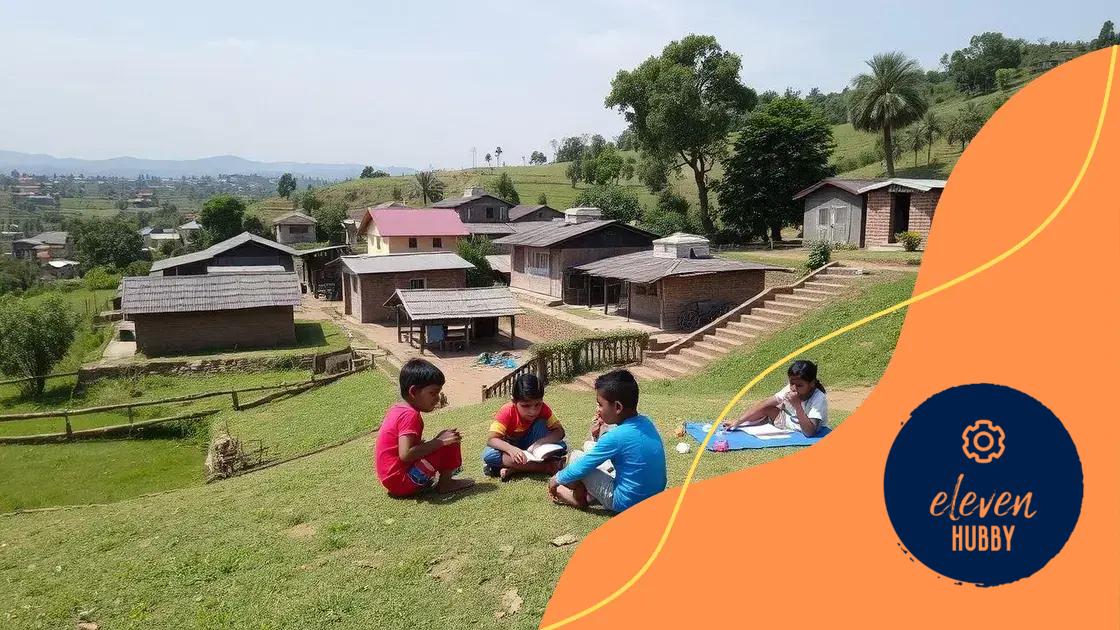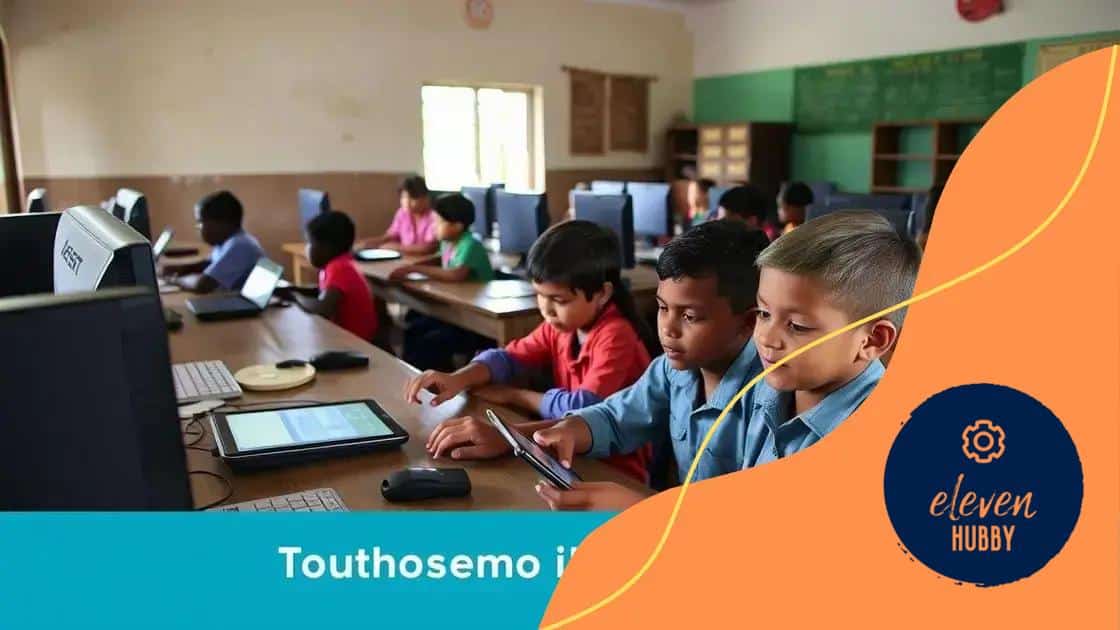The future of education for remote rural communities

The future of education for remote rural communities involves leveraging technology, community engagement, and innovative teaching methods to enhance learning outcomes and bridge the gap with urban education.
The future of education for remote rural communities is bright and full of possibilities. Imagine children accessing the same quality of education as those in urban centers. This article explores innovative solutions and the potential impact on their futures.
Understanding the challenges faced by rural communities
Understanding the challenges faced by rural communities is essential for improving education in these areas. Many children in rural settings struggle with access to quality learning resources. Geographic isolation, limited internet connectivity, and a lack of trained teachers create significant barriers.
Key challenges in rural education
Rural education is often under-resourced, leading to disparities compared to urban schools. This can result in:
- Limited access to advanced courses and extracurricular activities.
- Inadequate technological infrastructure for online learning.
- High student-to-teacher ratios in classrooms.
- Lack of community awareness and support for educational initiatives.
These challenges hinder student engagement and the overall quality of education provided. Furthermore, many rural families face economic hardships that can prevent children from attending school regularly. When resources are stretched thin, it becomes increasingly difficult to find qualified teachers willing to work in these remote locations.
Impact on student outcomes
The impact of these challenges is profound. Students in rural communities often experience lower academic achievements and reduced opportunities for further education. Motivation can wane when they see little hope for a brighter future. As a result, many students may drop out before completing high school.
In contrast, enhancing education in these areas can transform lives. By breaking down barriers, we can create a brighter future for these communities. With the right support and resources, students can learn effectively and achieve their dreams. Collaboration between local organizations and educational leaders is key to making the necessary changes.
Innovative education models for remote areas
Innovative education models for remote areas provide new opportunities for students who face unique challenges. These models aim to bridge the gap between urban and rural education, helping to create a more equitable learning environment.
Blended learning approaches
One effective model is the blended learning approach. This method combines traditional face-to-face instruction with online learning. It allows students to access educational resources from home while still receiving guidance from teachers in the classroom. Benefits of this model include:
- Flexibility in learning pace and style.
- Access to a wider range of digital resources.
- Increased engagement through interactive content.
Schools can implement blended learning by providing devices and internet access to students, ensuring that everyone has the opportunity to participate. Additionally, teachers can receive training to effectively integrate technology into their teaching.
Community-led education initiatives
Community-led initiatives also play a crucial role in revolutionizing education in rural areas. When local communities take charge, they can tailor the education system to meet their specific needs. This may include:
- After-school programs led by community members.
- Adult education classes to involve families.
- Partnerships with local organizations to provide resources and support.
These initiatives promote a shared responsibility for education, fostering a sense of ownership and connection among students and their families. By engaging community members, schools can develop programs that are both relevant and effective.
Moreover, leveraging local knowledge and resources helps to create a more sustainable and impactful educational environment. Innovative approaches such as small, multi-age classrooms can also support personalized learning and enhance peer relationships.
The role of technology in rural education

The role of technology in rural education is increasingly vital as it opens doors to learning opportunities that were previously unavailable. With the right tools, students in remote areas can engage with high-quality educational resources from anywhere.
Access to online resources
One significant advantage of technology is the access it provides to a wide range of online resources. Students can utilize digital libraries, educational platforms, and video tutorials. This allows them to:
- Explore various subjects at their own pace.
- Access interactive learning materials.
- Participate in virtual classrooms with teachers from other areas.
These resources help foster a love for learning and enable students to expand their knowledge beyond standard curricula.
Enhancing communication
Technology also enhances communication between teachers, students, and parents. Online platforms enable educators to send assignments and feedback quickly. This communication helps keep parents informed of their children’s progress, creating a supportive educational environment. Furthermore, tools like video conferencing allow teachers to connect with experts in different fields, providing students with unique learning experiences.
In addition, technology can reduce feelings of isolation that students in rural areas may experience. By connecting with peers through online forums or social media, students can share their experiences and collaborate on projects, fostering a sense of community.
Training teachers with technology
Another important aspect is providing professional development for teachers. Training programs can help educators learn how to integrate technology into their teaching effectively. This support ensures that they can use digital tools to enhance their lessons and engage students more deeply.
As technology continues to advance, it will undoubtedly play a larger role in shaping education in rural communities. Schools that embrace these changes can better prepare students for future challenges, making education more relevant and accessible.
Community involvement in educational initiatives
Community involvement in educational initiatives is crucial for enhancing the quality of education in rural areas. When local communities engage in educational programs, they create a supportive environment that fosters student success.
Building strong partnerships
One effective way to promote community involvement is through building partnerships with local organizations. These partnerships can provide valuable resources, mentorship opportunities, and volunteer support. Working together, schools and community members can:
- Organize events that promote education.
- Provide scholarships or financial assistance for students.
- Offer internships and job shadowing programs.
Such collaborations can motivate students by showing them real-world applications of their studies and helping them envision a brighter future.
Encouraging parental engagement
Another key aspect of community involvement is encouraging parents to take an active role in their children’s education. Schools can facilitate this by:
- Hosting workshops to educate parents on how to support learning at home.
- Creating parent-teacher organizations to foster communication.
- Involving parents in school decision-making processes.
When parents are engaged, students tend to feel more supported and perform better academically. This partnership between parents and educators builds a stronger sense of community.
Moreover, events like back-to-school nights or family engagement days can further strengthen this bond. These gatherings allow families to connect with teachers and learn more about school activities, reinforcing the idea that education is a shared responsibility.
Community involvement also cultivates a culture of learning. When local businesses and organizations support education, they signal to students that learning is valued. This can lead to increased motivation and academic achievement among students, as they see the community actively invested in their success.
Success stories from remote rural schools
Success stories from remote rural schools highlight the incredible potential and resilience of students and educators. These inspiring narratives demonstrate how communities can overcome challenges and create pathways to success.
Innovative teaching methods
Many rural schools have adopted innovative teaching methods that cater to their unique needs. For instance, some schools have implemented project-based learning, which allows students to engage in hands-on projects that connect to real-world issues. This approach helps students:
- Develop critical thinking skills.
- Work collaboratively with their peers.
- Relate their studies to everyday life.
Such methods have proven effective in boosting student engagement and performance, inspiring other schools to adopt similar practices.
Community support initiatives
In several cases, community support has played a crucial role in student success. Local businesses have partnered with schools to provide internships, mentorship programs, and resources for students. These initiatives not only benefit students but also strengthen community ties by fostering a sense of responsibility and investment in education.
For example, a rural community came together to create after-school programs that offer tutoring and enrichment activities. This collaboration has significantly improved academic outcomes and helped students explore new interests. Additionally, involving parents in these initiatives fosters a supportive educational environment.
Achievements and recognition
Many students from rural schools have achieved remarkable accomplishments, despite their challenges. Some have won regional and national science fairs, earned scholarships to prestigious universities, or gained recognition for their artistic abilities. These achievements not only uplift the students but serve as a beacon of hope for their communities.
These success stories illustrate the power of determination and innovative thinking. By harnessing local resources, fostering community involvement, and adopting creative educational practices, rural schools are making significant strides toward a brighter future for their students.
FAQ – Frequently Asked Questions about Education in Remote Rural Communities
What are some challenges faced by rural schools?
Rural schools often face challenges such as limited resources, geographic isolation, and a lack of qualified teachers.
How can technology improve education in rural areas?
Technology can provide access to online resources, enhance communication between teachers and students, and facilitate innovative learning approaches.
What role does community involvement play in education?
Community involvement fosters a supportive environment, brings resources, and enhances student engagement through local partnerships.
Can you share a success story from a rural school?
Many rural students have achieved remarkable accomplishments, such as winning scholarships or participating in national competitions, despite the challenges they face.






